“In rai, there are always enemies, there are always problems.”
Djillali, an Algerian fan (Shade-Poulsen 124)
It is no coincidence that rai surged onto the Algerian popular music landscape during the 1980s, a time in which Islamic reformists brought about new challenges to the political, cultural, and artistic scenes in the developing country. [Listen to an example of rai.] Caught between tradition and modernization, and reacting to the failure of socialism and its inability to appeal to the majority of the Algerian masses, the country sank into a brutal civil war between the military-backed regime and Islamic conservatives demanding a fair democratic election. Algerian rai artists responded by expressing disenchantment with their country’s situation through a modernized genre largely based on its traditional, folk-based, sacred ancestor. In Arabic rai means “opinion,” a word reflecting the desire for freedom of speech and expression, values that have been subjected to extreme censorship by non-democratic Arab governments. Currently, rai is associated with an emerging youth culture and the new connotations ascribed to the genre reflect tenets of liberalism that depart from the past. In its newly adopted form, rai represents an alternative mode of protest and liberation.
When new rai began to achieve popularity in Algeria and Europe in the late 70s and early 80s, rai artists and the conservative factions were at odds with each other because of their conflicting ideological positions. In their lyrics, rai singers reject older religious models, voice their resentment that pleasure would be associated with sin, and insist on free speech. Conservatives, on the other hand, claim that it is time to seek radical salvation for the country; they would provide an Islamic solution to the country’s increasing new challenges.
Scholars, from either the Middle East or the West, usually discuss rai from the vantage point of its political and sexual messages; both issues connect to the identity of the music and its audiences (see Schade-Poulsen). Many of those who listen to rai find power in its rhythms and highly politicized lyrics. For certain listeners, rai promotes cultural values that address particular taboos in the Middle East: immigration and assimilation, criticism of the state, modernization, and the place of sex and sexual activities within an Islamic society. Other listeners enjoy rai’s dance rhythms and its eclectic musical style without necessarily understanding or agreeing with its lyrics. One of rai’s strengths lies in its ability to appeal to diverse social groups.
As a transgressive popular music genre, rai combines Eastern styles of singing with Western instruments. Its rhythms mix complex Arabic and African patterns with Spanish flamenco, American disco, hip-hop, and reggae. Modern rai emerged from the Algerian port city of Oran on the Mediterranean in the early 80s, and by the early 90s rai had achieved enormous popularity in the Middle East, Europe, and, to a lesser extent, the U.S. Based largely on Algerian folklore of sha’bi, traditional rai was sung within a private domain by a cheikh, a person revered for his or her age or religious and social stature. In the 1920s and 1930s, rai re-emerged when oppressed and marginalized women adopted the pseudo-sacred genre and used it as a vehicle to express political, social, and sexual freedoms. In its most recent development since the early 80s, rai artists, such as Khaled and Rachid Taha, base their lyrics and singing style on the traditional genre. Pop-rai, as it is commonly known today, has become controversial throughout the Middle East due to its lyrics, its musical slippage (which resists definition and categorization), and its challenges to traditions. Rai singers’ strong political reactions to the civil war, coupled with their borrowing of Western instruments and rhythms, facilitated rai’s resurgence into the world’s musical scene where it stimulated debates regarding politics, identity, and sexuality among young Algerians living at home and abroad.
The politics, identity, and sexual narratives of Algerian rai have not received their due attention from music critics, sociologists, or musicologists. In the last two decades, since the genre re-emerged on the global popular music scene, scholars such as Andy Morgan, Tony Langlois, and Marc Schade-Poulsen, for example, have focused almost exclusively on rai’s origins and reception. Morgan provides a solid summary of the origin of rai and its major contributors, while Langlois examines aspects of the local and the global within the context of popular music. Schade-Poulsen’s book presents an excellent study on the social significance of rai as a powerful force within Algerian (male) youth society. While such studies advance our understanding of the genre, they ignore that rai is a musical statement rebelling against political, social, and religious constraints. Central to my argument is the reception of rai: who embraces it, who opposes it, and why. I further attempt to situate rai within a global position of world music, and focus in particular on its transgressive and discursive qualities as a rebellious musical genre that defies labeling and celebrates its multiplicity.
I am most concerned with the concept of identity among rai’s audiences and artists. In examining rai, I analyze its musical and political contexts and look at how politics and sexuality converge to frame the lyrics and musical styles of a defiant genre. Using the political and cultural crisis in modern Algeria, rai artists inject their music with fiery lyrics, funky beats, and Western instruments, while calling for an end to violence in a country torn by a bloody civil war. Through this process, rai artists reveal their social, political, and moral identity through lyrics that express pain, anger, frustration, as well as love, desire, and a quest for social and political freedom. While surveying the re-emergence of rai in the past decades, I focus specifically on its most visible artists, selecting repertory from Cheba Fadela, Cheb Hasni, Cheb Mami, Rachid Taha, and Khaled.
From Oran to Marseilles: The Re-birth of a Genre
In the early 1900s, rai was sung and performed by men respected for their strong moral and social stature in the city of Oran. The singers were referred to as cheikh, a term meaning “honorable” or “master.” Their rural songs combined the sentimentality of ballads and the mysticism of the Sufi tradition, and they accompanied their vocals with gillal (a drum), gasbah (a wooden flute), and, most importantly, hand clapping. Musically, the repetitive melody, percussive beat, audience participation through dancing, hand clapping, and joyous ululations, are all prominent elements of Algerian folk traditions, sha’bi. They are also characteristics of Sufi music designed to promote the metaphysical state of tarab (musical rapture or ecstasy) through the practice of sama (listening) (see Racy, “Creativity”). Rural rai was performed in small, private, sacred, and social gatherings such as weddings, religious ceremonies, and the celebration of circumcision. They were attended by close members of the family and honored guests and the music was enjoyed by a selected group for selected events.
In the 1920s and 1930s, peasant women began to resist severe injustice and domination by men. Their desires to express themselves and enjoy their own bodies were surrounded by taboos. But due to colonialism, French occupation, and the deteriorating economy, some women were forced to work in nightclubs, cabarets, and even in brothels to meet the harsh demands of life. As a result, a group in rural Algeria emerged from the dust of old traditions and poverty: women and daughters of peasant laborers and orphans who became known as “women of the cold shoulder.” These women challenged local traditions by adapting the style and songs of the cheikhs with a “‘shocking’ approach to poetry and music” (Morgan, “Rai” 415).1 As a group, this stratum of society shared many similarities with European gypsies in dress and behavior. Morgan links the inspirations for their art to the concept of mehna, an Arabic term for suffering and hardship, which he compares to the notion of duende from the Flamenco tradition (Morgan, “Rai” 417). The cheikhat, as they came to be labeled, were viewed by the rest of the male and traditional female society as a threat. Perhaps it was the linking of rai to mehna in this context that first opened this musical genre to expressing “opinion” and protest.
Socially segregated from the rest of the society, the cheikhat felt free to challenge conventional rules and roles of women. The lyrics, tempo, and style of the private and sacred genre had to be drastically modified to suit its new purposes and audience:
For all the distance traveled, rai has always been a music of the margins. Cheikha Remitti has been singing sex and drink for over half a century, and the chebs and chebas still exile themselves from polite society with lyrics like “We made love in a run-down shack.” (sic) (Rosen 22)
Remitti’s radical message, however, did not stop at describing sexual pleasures and breaking traditional female boundaries. When the armed Algerian resistance broke out against the French following WWII, Re

mitti (born in 1923) did not hesitate in joining the resistance. Proudly she stated: “The FLN (Front de Liberation National) didn’t have to contact me. Straight after the uprising of November 1, 1954, I began to sing about the armed struggle…to brave the colonial police and sing about a free Algeria in public” (Morgan, “Thursday Night Fever” 128). Remitti’s legendary stature serves as vital inspiration for current rai singers like Cheba Fadela and others who echo similar sentiments. Following the revolution and Algeria’s independence from France in 1962, the legend of the cheikhat continued to affect Algerian society and its social values. The cheikhat further inspired female singers to articulate and contest the prohibitions against expressions of female sexuality and outspokenness on political issues.
According to Rabah Mezouane,
Remitti is undoubtedly the most radical of the cheikhats. She is also the one who founded the thematic bases of rai as it is played on today and the artisan of a “poetic” technique which lies on an inventory of words including the allusive sexual jargon of the red-light districts…, the drawling tonic accent of the village idiom and the list of metaphors, double meanings and the clichés of the malhûn.
In the post-revolutionary Algeria of the mid 1960s, artists focused on modernizing rai by making it danceable, replacing some of the traditional instruments with European ones, and cutting the length of songs in half. At this time, Oran was the center for numerous musical traditions, including the classical Arabic-Andalusia tradition and its close affiliates, the art songs of the malhûn and sha’bi, as well as influences from Spanish flamenco and American jazz, which were introduced by soldiers during WWII. In order to separate themselves from previous associations connected with rai, the new generation of rai singers called themselves “cheb,” (masculine) and “cheba” (feminine) meaning young, not only to denote their youth but also to distinguish their art from that of the their predecessors. Situating themselves against traditions, rai artists came to be associated with rebellion and a brand of marginality that soon became mainstream and the mark of a whole new generation.
Rai had to be made accessible on more than one level. Lyrics were modified from the proper qasida (classical Arabic poetry) to incorporate topics and dialects taken from everyday life. Musical structure was altered drastically so that a single musical unit could serve for many verses, and songs became shorter and less complex. Gone was the long muqaddimah (musical introduction), which on its own can last several minutes. The tempo was radically accelerated through the use of Western rhythms drawn from disco and reggae. Rai artists also modified the traditional ensemble by introducing instruments associated with Western pop, such as guitars, keyboards, and synthesizers, and these instruments inspired a different approach to harmony. Even though some instruments—keyboard, accordion, and saxophone—were modified to play the Arabic quartertone, rai uses the conventional scales shared by Western traditions (major, minor, and phrygian mode, in particular are popular). Finally, rai borrowed from different international styles to achieve legitimacy as popular music. The use of blues chord progressions, Jamaican reggae, and disco arrangements give the music its diversity of style, energizing it and giving it additional sophistication.
These changes were made possible by new technologies and the consequent shift in the site of musicking, from live concert to the studio.2 Technologies associated with studio recordings, electric keyboards, synthesizers, amplified sounds, and drum machines allowed for the abandonment of the large Egyptian style orchestra used in sha’bi in favor of a smaller, more intimate, and more economical band. The drum machine replaced the percussion ensemble while the synthesizer substituted for the large string section. As Simon Frith argues, recordings and technology create a public means of emotionally complex communication. By embracing new performing and musical styles, rai artists also move audiences by coding their music with a different type of personal aura. Cheba Fadela and Cheb Sahraoui rely on their deep rough voices, which are traditional for rai singers but not particularly favored in the Arabic world.3 Khalid’s “rebel” image is well known from his drinking and smoking while living in Paris. By allowing for the exaggeration and manipulation of voices, technology helps singers further create a self-determined image and promote themselves as celebrities.
Changes in music were also accompanied by changes in function. The increased 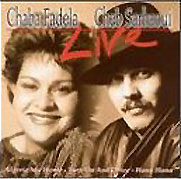 availability of rai through radio, cassette, live concerts, and music videos, made rai accessible to a larger and more diverse audience. Algerian producers have limited funds and technology—in fact, only few own 24-track studios. Rachid Baba Ahmed and his brother Fethi have been the most famous rai producers in Algeria. Active in the 70s, 80s, and 90s, they were the first to introduce the complete synthesizer and drum-machine sound into rai in 1982 (Schade-Poulsen 17–18). Island/Mango records was for a while one of the chief sponsors of pop rai and was the first to sign Cheba Fadela and Cheb Sahraoui, whose album N’sal Fik (You are mine) is considered by many the first rai record to achieve international recognition. They followed that record with Ana Ana (Me and Me), which included a complete translation of the lyrics into English on the inside CD cover.
availability of rai through radio, cassette, live concerts, and music videos, made rai accessible to a larger and more diverse audience. Algerian producers have limited funds and technology—in fact, only few own 24-track studios. Rachid Baba Ahmed and his brother Fethi have been the most famous rai producers in Algeria. Active in the 70s, 80s, and 90s, they were the first to introduce the complete synthesizer and drum-machine sound into rai in 1982 (Schade-Poulsen 17–18). Island/Mango records was for a while one of the chief sponsors of pop rai and was the first to sign Cheba Fadela and Cheb Sahraoui, whose album N’sal Fik (You are mine) is considered by many the first rai record to achieve international recognition. They followed that record with Ana Ana (Me and Me), which included a complete translation of the lyrics into English on the inside CD cover.
Rai emerged in the 80s as one of the world’s leading musical representatives of pop culture and World Beat. Artists like Khaled, Cheb Mami (the “Prince of Rai”), and Cheba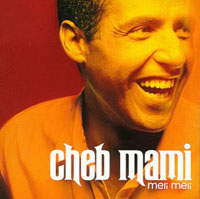 Fadela sold millions of records world wide. In Europe, Khaled (the “King of Rai”) emerged as the premier celebrity of the genre and managed to land a major producer, Don Was, who gave him greater international exposure. As a result, Khaled’s self-titled 1992 CD claimed universal success due, in part, to higher quality recording and distribution. Khaled’s 1992 smash hit “Didi” was popular in nightclubs for months and eventually earned him a Cesar (the French equivalent of the American “Oscar”) for best soundtrack album in France. While touring the Middle East, Khaled enjoyed audience sizes unprecedented since the peak of Egypt’s ughniya (popular song) in the 70s, which included singers such as Umm Kulthum, Abd al-Wahhab, and Abdul Halim Hafiz. By the late 90s, rai dominated the world music market, achieving major success throughout Africa, Asia, Europe, and North America. Seeking greater exposure and freedom, most rai artists left their war-torn Algeria and settled in France where they continue to produce concerts and albums with increasing popularity.
Fadela sold millions of records world wide. In Europe, Khaled (the “King of Rai”) emerged as the premier celebrity of the genre and managed to land a major producer, Don Was, who gave him greater international exposure. As a result, Khaled’s self-titled 1992 CD claimed universal success due, in part, to higher quality recording and distribution. Khaled’s 1992 smash hit “Didi” was popular in nightclubs for months and eventually earned him a Cesar (the French equivalent of the American “Oscar”) for best soundtrack album in France. While touring the Middle East, Khaled enjoyed audience sizes unprecedented since the peak of Egypt’s ughniya (popular song) in the 70s, which included singers such as Umm Kulthum, Abd al-Wahhab, and Abdul Halim Hafiz. By the late 90s, rai dominated the world music market, achieving major success throughout Africa, Asia, Europe, and North America. Seeking greater exposure and freedom, most rai artists left their war-torn Algeria and settled in France where they continue to produce concerts and albums with increasing popularity.
I. Rai Politics
1) Algeria
Algerian contemporary politics are shaped by the failure of the past ruling regime to implement fair, free, and democratic elections. Indeed, the fuel that generated civil unrest since 1991 was primarily the government’s cancellation of election results that would have insured an Islamist victory under the leadership of the Islamic Salvation Front (ISF), which gained a surprising 54% of the vote. Threatened by the victory, the army took over, forcing the resignation of President Benjedid in 1992, and the next eight years saw a succession of presidents who resigned or were assassinated due to political upheaval in the country. The last two decades of the 20th century in Algeria were marked by military rule against a rising Islamic rebellion that resulted in the death of hundreds of thousands of innocent civilians.
Algerian artists and intellectuals have responded to the political crisis and bloody civil war by 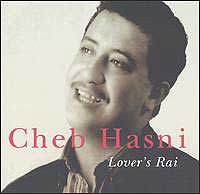 voicing their concerns over Algeria’s future. Because they have been critical of the violence, divisions, and hostility within their nation and the government’s failure to live up to either the Socialist or Islamic principles it has advocated since the country’s independence (Langlois 270), Algerian artists and intellectuals have been subjected to violent attacks and kidnapping. Cheb Hasni was a leading rai artist who dedicated most of his songs to love and its torments. As one of the promising young stars residing in Algeria, he produced songs distinguished by their slow tempo and nostalgic love topics. Accordingly, he was nicknamed the “Prince of Love Rai.” In October of 1994, Cheb Hasni was brutally murdered in front of his house in Oran. Less than five months later, Rachid Baba, one of Algeria’s most innovative producers, was shot outside his record store. Though no one claimed responsibility for their murders, the Western media was quick to point the finger at Muslim extremists, as can be seen from Emmanuel Legrand’s assessment of the incidents:
voicing their concerns over Algeria’s future. Because they have been critical of the violence, divisions, and hostility within their nation and the government’s failure to live up to either the Socialist or Islamic principles it has advocated since the country’s independence (Langlois 270), Algerian artists and intellectuals have been subjected to violent attacks and kidnapping. Cheb Hasni was a leading rai artist who dedicated most of his songs to love and its torments. As one of the promising young stars residing in Algeria, he produced songs distinguished by their slow tempo and nostalgic love topics. Accordingly, he was nicknamed the “Prince of Love Rai.” In October of 1994, Cheb Hasni was brutally murdered in front of his house in Oran. Less than five months later, Rachid Baba, one of Algeria’s most innovative producers, was shot outside his record store. Though no one claimed responsibility for their murders, the Western media was quick to point the finger at Muslim extremists, as can be seen from Emmanuel Legrand’s assessment of the incidents:
The killing is believed to have been carried out by Islamic fundamentalists, who have attacked a number of prominent members of the intellectual and artistic communities during the three-year conflict. Rai, with its themes of romance and everyday living, has been a long-standing target for Islamic movements, whose followers see it as a perverter of youth. (48)
Legrand’s statement is not surprising since many Western journalists tend to highlight the tension between rai artists and the rise of the Islamic movement in Algeria. Such arguments serve to promote rai as a rebellious genre and ally it with Western rock while condemning Islam as a religion hostile to music and the arts.
The distrust of the government by Algerian artists can be seen in the writings of the Berber 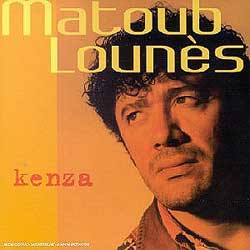 nationalist singer Lounès Matoub, who served in the military in the 1970s. Matoub, who quickly became disillusioned by the government and began singing about the corruption that filtered through the military, voiced his critique of President Hawwari Boumediene’s oppressive regime:
nationalist singer Lounès Matoub, who served in the military in the 1970s. Matoub, who quickly became disillusioned by the government and began singing about the corruption that filtered through the military, voiced his critique of President Hawwari Boumediene’s oppressive regime:
I also began to understand that I served a power whose goods were antithetical to my convictions…. I started to understand that this permanent fear in which our population lived had a name: military security, and that behind it, there was one man, Boumedienne—always him. (Matoub 61–62)4
In his illuminating autobiography Rebelle, written shortly before his assassination in 1995, Matoub spoke about his songs and how they served to promote the nationalistic identity of the Berbers who were reacting against Islamization in Algeria. Although rai was being targeted by an unknown enemy, it was also establishing itself as a recognized influence on the determination of Algeria’s political future and construction of identity in Algerian society.
As the country sank into civil war, reports of brutal massacres and mass graves involving Algerian government death squads filled the media and thousands of civilians were caught in the crossfire. The political system became more and more polarized, and as the economy reached catastrophic levels of food shortage and massive unemployment, Algerians were overwhelmed with feelings of resignation, dread, and anger: “Fear is in the heart, but life goes on,” explained a woman in Algiers (qtd. in Ciment 1).
2) France
Fleeing their war-torn country, most rai artists sought refuge in France due to their special immigration status and historical relationship based on the colonial past. There, they were able to express their sentiments against the harsh life in their villages and towns with less fear of persecution and censorship. They were also exposed to international audiences, better recording technology, and new musical styles that contributed to the flourishing and popularity of rai. Yet, artists, as well as their fellow North African immigrants, soon realized that they were not welcomed by all factions in France and they began to suffer from and react to the harsh discrimination and prejudice advocated by France’s right-wing party, the National Front (FN). The resurrection of the FN on the French political scene coincided with growing intolerance and xenophobia towards immigrants. Adapting a policy of exclusion and spreading ideologies of fear and hatred toward Muslim immigrants, the FN established its reputation as an exclusionist anti-immigration party.
The FN’s stance towards immigration involved launching war against Islam as an alien culture and religion that threatens the Christian identity of the West. Citing Islam’s stand on Jihad, or Holy War, exploiting its laws and highlighting crimes by North African immigrants, the FN emphasized the violent and alien aspect of Islamic culture as a “threat” to French society. French Nationalist writer Marie-France Stirbois explains:
With each day, Islam inserts itself gradually in our lives, our laws, [and] our customs. Soon…Islam will occupy our churches in order to pray to the Prophet…. In Algeria, the partisans of Islamanization march in the streets and do not hesitate to attack the courts that want to uphold the law. In Egypt,…(they) wear the veil, provocative affirmation of their identity. (qtd. in Davies 149–50; emphasis added)
Naturally, such hostility results in numerous attacks by right wing supremacists against Algerians and Africans in general. One such deliberate act, on February 21, 1995, involved the murder of Ibrahim Ali, a seventeen-year old singer who was a French citizen of East Africa’s Comoro Islands. Heading home following a late rehearsal, Ali was murdered by an unemployed French construction worker who was in the company of FN members. They had just plastered a wall with blue-and-white party posters bearing the slogan “Immigration Equals Unemployment.” “What happened in Marseilles was an isolated incident,” claimed Kofi Yamgnane, who was in charge of integration matters for the previous Socialist government and was also the head of the Private Foundation for Republican Integration. “But the atmosphere in which racism is legitimized, an atmosphere created by the current French government, has made some believe they have the right to do things like that” (qtd. in Kraft 1, 5).
Rai Music and Narrative
Caught between the harsh realities inside Algeria and France, rai artists directed their lyrics to address social and political tensions, demanding reforms and freedom. Khaled’s songs such as “El Harba Wayn” (“Where to Flee”), “Wally L’Dark” (“Go Back Home”), “Wahrane” (“Oran”), “Wahrane Wahrane” (“Oran Oran”), and numerous others, are all fueled by the political climate that exploits the Algerian dilemma. The song “Wahrane” from Khaled’s 1992 self-titled album combines sexual metaphors with political and social puns aimed at criticizing the undemocratic regime in Algeria, especially the increased violence and injustice in his native town of Oran. The lyrics express the singer’s yearning for justice in his hometown, which is dominated by corrupt police and crime. The singer emotionally conveys his worries for the city, especially at night when the sounds of guns disturb the peace. Toward the end, Khaled’s emotional attachment to Oran is metaphorically compared to a beautiful woman with whom the singer hopes to “unite.”
“Wahrane” is drastically different from the preceding songs on the CD. The absence of percussion and bass, and the use instruments such as the accordion, keyboard, and acoustic guitar, add intimacy and passion to the song. The acoustic guitar, the harmonic minor scale, and the melodic construction of the piece give it a flamenco flavor, a prominent feature of sha’bi and also influential in rai. In a recent study, Ali Jihad Racy showed how the famous “Asturias” by Isaac Albéniz have been influential in improvisatory passages by celebrated Arab ud players such as Farid al-Atrash of Lebanon and Munir Bashir of Iraq (“Many Faces” 313). In North Africa, this style is even more prevalent—it is celebrated and cherished as a continuation of Arab-Spanish history, culture, and music linking to the time of Arab presence in southern Spain. “Haramtou bik Nouassi” (“[Because of your love] sleep is forbidden to me”) by Reda Doumaz is one of many examples within Algerian popular music that evoke cultural interactions between North Africa and Spain through improvisation on the ud and guitar, based largely on the “Asturias.”
song. The acoustic guitar, the harmonic minor scale, and the melodic construction of the piece give it a flamenco flavor, a prominent feature of sha’bi and also influential in rai. In a recent study, Ali Jihad Racy showed how the famous “Asturias” by Isaac Albéniz have been influential in improvisatory passages by celebrated Arab ud players such as Farid al-Atrash of Lebanon and Munir Bashir of Iraq (“Many Faces” 313). In North Africa, this style is even more prevalent—it is celebrated and cherished as a continuation of Arab-Spanish history, culture, and music linking to the time of Arab presence in southern Spain. “Haramtou bik Nouassi” (“[Because of your love] sleep is forbidden to me”) by Reda Doumaz is one of many examples within Algerian popular music that evoke cultural interactions between North Africa and Spain through improvisation on the ud and guitar, based largely on the “Asturias.”
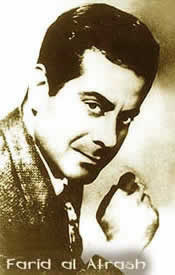 |
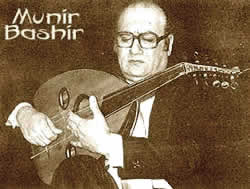 |
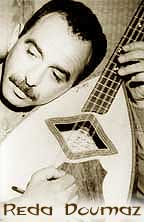 |
Khaled’s “Wahrane,” however, is more intricate in its allusions and construction since it sustains a gradual increase of intensity through its textual images and alternation between the singer’s voice and musical interludes. As the song develops, the musical interludes grow more aggressive, enhancing the violence embedded in the lyrics (see table 1 below):
Table 1: Outline of Khaled’s “Wahrane” (Khaled, Barclay 1992)
|
Interlude 1
|
Verse 1
|
Interlude 2
|
Verse 2
|
Interlude 3
|
Verse 3
|
Interlude 4
|
Verse 4
|
Interlude 5
|
 |
 |
 |
 |
 |
 |
 |
 |
 |
The melodic movement of the piece is seductive and saturated with embellishments, grace notes, and turns performed by the accordion. The acoustic guitar provides the harmonic accompaniment with a standard progression (i–iv–V–i). As with the song’s melody and phrases, the scale fluctuates between the melodic G minor and the Phrygian mode on D (separated only by an F–sharp). Khaled uses melodic and harmonic ambiguity to reflect the allegorical association of the city with the unattainable lover. This is expressed in the song by the gradual intensification of the interludes and in Khaled’s final cries in the postlude, which becomes more dissonant and fragmented. Oran, therefore, is not just a city occupied by violence and civil unrest, but Khaled’s ever-traveling soul as well. More than a city, it is also a restless state of being resulting in agony and departure.
The flirtatious overlapping of voices between the dominant male voice and the “feminine” twists of the accordion express the song’s sexual rhetoric. Initiating the seduction, the accordion ascends with a grace note from the tonic G to B–flat. Even though the accordion accompanies the vocal line, it always plays around it, often anticipating the melody and resolving it. But the vocal line centers around the Phrygian mode on D, thus resisting the seduction of the instrument to cadence on its tonic, G. The tension and flirtation between the two represents both the yearning for and the fear of being away from the other. Toward the end of the piece, the embellishments increase with the participation of the guitar in overlapping improvisatory accompaniment. Khaled’s voice soars high on the ascending interlude figure of G–F–Eb–D, and begins to sing in a style similar to the accordion. When all the instruments finally unite playing the descending line, Khaled uses this opportunity to add more embellishments and modifications to the descending line: G–D–F–C–Eb–Bb–D (the bold letters represent the initial notes of the interlude). As the reality of separation between him and his beloved homeland is confirmed, Khaled’s voice erupts in fragmented wailing of pure anguish and extreme agony.
Khaled employs a similar narrative in his more traditional, yet equally effective, “Wahrane Wahrane,” from his 1996 CD Sahra. He shifts to his remarkable low voice accompanied by a steady and strong rhythmic beat of two eighth notes followed by a half note in duple meter and supported by the luscious Arabic orchestra of strings playing in unison. But when Khaled’s lyrics address the agony and misery of exile and departure, the strings sink in a descending chromatic line amplifying the pain and apathy of the Algerian struggle. The middle section is more lyrical and optimistic as Khaled recalls his childhood and the nights he spent with friends singing and drumming. Soon, however, dark images of violence creep in, sending the singer weeping for the loss of his homeland. A short melancholic improvisation on the violin followed by an unconventional final cadence on the dominant leaves the song with a sense of defeat and suspension. Obviously, Algeria is caught in a web of complex and painful mehna (agony).
|
Khaled, “Wahrane Wahrane” |
||||
|
I Oran Oran You’ve lost II Oh how happy I am for the descendents of El Hamri III Oh, how happy were the parties in my homeland Taha’s deep voice intensifies feelings of pain and agony. The strong down beat of the song allows Taha to accent the first word of each line as if the words are uttered by force and with struggle, thus magnifying the poetic II. Identity/ReceptionIn his discussion of popular culture, Stuart Hall argues that culture constitutes more than a fixed set of criteria. He sees culture as a struggle involving several dynamics such as incorporation, distortion, resistance, negotiation, and recuperation (236). Becoming part of the historical process in which forces both disappear and reappear in various forms and disguises, culture involves the articulation of elements with no inscribed position, elements that can be rearranged and reorganized. Culture is conceived not as a separate “way of life,” but as “ways of struggle” constantly intersecting at crossroads which yield hybrid cultural genres, such as rai. When rai artists adapt older lyrics within a new musical context, and when their message reflects the social and political conflicts of the Algerian population living in both Algeria and France, they enact precisely those ever-changing struggles within a larger historical context as expressed by Hall. As a manifestation of postmodernist capitalism and industrial technology, rai addresses contemporary oppositions, such as traditional versus modern, sacred versus secular, and Arabic versus Western. An artist such as Khaled embodies these oppositions when he celebrates sex and drinking in one song (“Serbi Serbi”), yet retracts from them in other songs (“Wahrane Wahrane”).8 / Who abandoned their religion and followed the glass / How shameful it is on the dining table / For it is surely a useless companion.”] Rai lyrics and music celebrate intercultural coalescence and conversation without abandoning their Arabic heritage. In songs by Khaled, Cheikha Remitti, Rachid Taha, and Cheb Mami, we are constantly reminded of images of the desert and its symbolic association with Arabness. Khaled’s “El Arabi” (“The Arab”), “Sahra” (“The Desert”), Remitti’s “La Camel” (“The Camel”), Taha’s “Bent Sahra” (“Daughter of the Desert”), and Mami’s “Saida” (the artist’s hometown), all conjure the geographic beauty of the homeland with its dunes, oases, palm trees, and women. Many of these songs are based on the musical genre about the Algerian Sahara known locally as “ay ay,” which uses minimal instrumentation (including only flutes and drums) and lyrics rich in poetic chivalry and romance. To bring the imagery to life musically, the songs also employ a duple meter and a strong down beat rhythm that matches the pace of the caravan. But just as some songs root themselves in images of the desert and Middle Eastern terrains, others, often on the same album, journey to world cities such as Marseilles and Chicago. Cheb Mami’s style, for example, is well known for his use of bi-and tri-lingual lyrics (Arabic, French, and English) in songs that combine rai with French rock and rap. Thus, rai combines the local and the global in one genre that flourishes in its multi-vocality, contradictions, and defiance of categorization. The fusion between the traditional and modern within a globalized postmodern context creates newly hybrid sounds. Some songs sound rhythmically Western but many also have a strong Arabic flavor. Utilizing the rich cultural heritage of Algeria, rai artists bring to the surface issues of identity, culture, and tradition utilizing old music and playing it within a new medium. Indigenous and Western sounds are combined, played, and composed side by side without contradiction. Rai by nature fuses multiple sources because of its origins in Oran, a sea-port with multiple ethnicities and traditions. As an example of musicking, Rachid Taha’s 1998 album Diwan does not claim to be completely new; its strength lies in reworking songs by the “old masters,” such as Dahmane El Harrachi, Massaoud Bellemou, and Farid al-Atrash. These common fluxes of culture remind us of rai’s fluidity and durability. In the world of globalization and fast communication, musicians find themselves closer to one another in their concerns and artistic achievements. Collaboration and borrowing replace individuality and monoculture. Each artist now finds him/herself not only belonging to a vast global village, but participating in its identity. Like the Pakistani Sufi music of the Qawwali tradition, led by Nusrat Fateh Ali Khan who collaborated with singers like Eddie Vedder of Pearl Jam, and like the South African group Ladysmith Black Mambazo’s work with Paul Simon, collaboration is not without its problems. Cheb Mami gave rai international exposure through his collaboration with Sting in “Desert Rose.” Yet, for artists from the Middle East, embracing Western culture often clashes with traditional values. Older generations often complain about the new generation’s lack of identity and cultural specificity. Authenticity and creativity become major concerns and a source of a great deal of tension between the preservation of the past and the creation of the present, as argued by Timothy Taylor:
In rai, as in pop culture throughout the Middle East, the debate regarding originality and authenticity is often linked with turath, heritage, and nostalgia. While many argue that the return to turath is the basis for creating a strong modern Arab culture, others demand reform based on Western models. Rai’s vulgar lyrics, revolt against traditional values, and promotion of [Western] decadence, raise objections and controversy, and represent only one dimension of this complex cultural debate. Its rejection of taboos in a society of traditions is an assertion of a new identity in an era of postcolonial negotiation. Khaled explains: “It’s not poetry. It’s speaking, expressing yourself, talking, and making yourself heard, saying what you want to say” (qtd. in Rosen 22). Rai seems to embody binary forces: high and low, conservative and liberal, traditional and commercial, poetic and vulgar, Western and Eastern:
By making their own rules, rai artists have been accused by Arab critics of “polluting” the indigenous Algerian culture. The fact that rai artists use traditional folk melodies and reincorporate them within a new format often using modest budgets and technology, especially within Algeria, has led to many negative reactions from Arab and Western critics alike. Arabs often voice their concerns regarding “authenticity” and the need to “preserve” and insulate their culture, considered by many to be sacred and its meanings fixed once and forevermore. The borrowing and recycling of folk melodies was considered threatening to the values of tradition, and these non-conformist traits of rai led the Algerian government to label rai “rebel music” and to regulate its broadcast privileges on radio until the popular interpretation of “rebel music” was convincingly appropriated by national sentiments. But in 1985, the Algerian government sponsored the first international rai festival in Oran. The post-revolutionary government in Algeria has assumed a favorable stance toward rai, primarily because of its outspoken conflict with the fundamentalists. By sponsoring rai, the Algerian government also hoped to present itself as liberal by promoting free speech. The politically loaded festival was a testament to rai’s deeply penetrating message within Algerian society. Currently in Middle Eastern artistic circles, authenticity is almost always associated with the past and most of its advocates cling to it with a sense of nostalgia that is ever present in the vibrant culture of the Arab world.9 Citing evidence such as vulgar lyrics, repetitive tempos, and “lack of originality,” many critics of rai accuse contemporary artists of polluting and contributing to the cultural decline of Arab music. Authenticity is further linked to issues concerning modernity, often articulated in opposition to Westernization. While many tend to view these tensions as binary, it is much more constructive to examine these cultural parameters as important signifiers occupying the postcolonial Arab world in its struggle to reconcile its past with the present and future. Neither culture nor rai are fixed entities. Concepts such as authenticity and modernity are in constant flux, contesting and interacting with many other complex parameters within culture. Islamists in Algeria object primarily to rai’s lyrics, which they consider offensive, obscene, too French, too Western for Arabic culture, and too discordant with the teachings of Islam. They often master covert operations to harass and attack their opponents. Khaled raises objections to the censorship from Islamic reformists: “They come [to our concerts] and break things up. They say rai is street music and that it’s debauched. But that’s not true. I don’t sing pornography. I sing about love and social life. We say what we think, just like singers all over the world” (Lipsitz 125). Yet what sounds “too Western” for some Algerians is also very Arabic to others. Questions regarding the essential nature of rai are controversial among audiences from different parts of the world. To the Algerian and Moroccan immigrants who live in Europe, rai is an artistic connection that bonds them to their roots, helping them survive in a hostile culture. The shifting ideologies and cultural values in postmodern Algeria continue to set “new” boundaries and create new margins to be explored and challenged. Conservatives are not the only opponents of rai in the Middle East. Most music scholars also voice their concerns over the music and its national “identity,” for they see nothing artistic in its simplicity and often dismiss it as “noise.” Their main objection lies in its departure from the ethos of classical Arabic music, which is rooted in the tradition of the maqam (mode). But why judge pop rai by standards that apply to older music of the court or to the Egyptian ughniya of the 60s and the 70s? Many of these critical voices come to us from Egypt, a country that, for several centuries, has dominated the Middle Eastern cultural and artistic scene. In the past four decades, the Egyptian culture industry has set the standard for music, film, art, and dance. As countries such as Lebanon, Syria, Saudi Arabia, and Algeria catch up in their cultural productions, not the least of which includes rai music, objections from Egyptian critics towards Algerian rai reflect the intense debate in the Arab world regarding modernity and how art and culture should proceed. Interestingly enough, rai is not the only modern genre targeted by the traditionalists, i.e., advocates of “classical” music, who view Western influences on Arabic music in negative terms. In his evaluation of popular Arabic music in Israel, for example, Suheil Radwan voiced his concern regarding the infiltration of such “cheap songs performed in a pop-rock style, imitating the Anglo-American rhythmic patterns, using keyboard instruments, bass guitar, and with an emphasis on the rhythmic role played by the drums, cymbal, and tambourine.” He adds: “Traditional instruments are losing their importance in these ensembles. The main goal of the singers and players is to motivate the young people to dance in a hysterical way. The songs are performed in a monotonous style that tries to imitate the popular singers of Egypt and Lebanon” (42). The Egyptian position represents a complex struggle involving rai artists, technology, and tradition. By taking the music from its private social milieu of music-making to the studio, rai artists provoke objections to the unnatural and slushy sound introduced by the use of synthesizers and modern recording technology. Many Arab critics argue that the musicking of rai takes them away from their long established traditions. Arabic music has long been associated with the concept of sama (listening), which involves a dialectical relationship between the singer/musicians and the audience. Racy has demonstrated the importance of this relationship, arguing that in Arabic aesthetics, the creative process stresses “listener consciousness” and places the creative process within the domain of “social accessibility” (“Creativity” 10). Racy specifically relates this to music, which derives its momentum from human interplay and feedback involving the artist and the initiated listener. It is this relationship between the artist and his/her listeners that is missing in a recording that excludes audience participation. In live performances, Arab artists gain their audience’s respect and admiration by using their hala, or aura, and by demonstrating their mastery of modulation and exploration of the maqam. It is an aura emanating not of stardom, but rather of superior communication of emotions through control of musical and vocal dialectic, the In Western media, rai has become a kind of North African rock, and the Algerian city of Oran is nicknamed “the Las Vegas of Algeria.” In short, the originality and creativity of Algerian artists is always measured in terms of Western counterparts as opposed to its original Middle Eastern parameters. Such reactions to rai echo a long history of cultural prejudice against the Middle East, and against Arabs in particular. The position of Western critics who view rai as a “tacky imitation” Yet the significance of rai lies in its ability to capture listeners around the globe, even without its language being understood in its biggest markets: Europe and North America. Most non-Arab nations feel that it is not necessary to understand the words in order to enjoy the music. And although rai’s funky beat, vocal note bending, and mixture of Eastern and Western sounds are a truly beautiful aesthetic experience, European and American audiences miss out on its powerful texts: its mixtures of sacred and secular, its political voices, and its noble messages of love, freedom, and peace. Peter Spencer explains how world music affects American listeners by transposing them into a different space without exposing them to the dark reality of its complex lyrics and its symbolism:
Like many Western music critics, Spencer emphasizes the “entertaining” and charming qualities of world music, as well as its exotic sounds. By focusing primarily on its festive and celebratory side, Spencer fails to mention the agonizing side of rai. Joe Gore advocates a similar position when he writes: “Pop rai blends Islamic, Spanish, French, black African, and disco elements in a spicy stew of wailing vocals, cheap-sounding drum machines, and brittle electric guitars.” In the same article, Gore refers to rai fans in Europe and the U.S as “cult” members, thus singling the music out as exclusive, bizarre, and alien (110). The association of music followers to a cult is exaggerated and distorted. The struggle to claim or disclaim rai music has ramifications that extend beyond the sound of rai. Rai’s political and social ideologies beckon its audience to take a stand, to be active listeners, and to participate in the current social and political issues in Algeria and abroad. III. Rai and SexualityLike rock of the 1950s, rai lyrics alarmed many conservative factions in Middle Eastern society. Those who grew up with the noble poetic verses of the malhûn (traditional Algerian love-songs) and the qasida tradition struggle against lyrics that lack poetic rhyme and the highly symbolic text of the Arabic literary tradition. In all respects, rai violates not only the genre’s own traditions, but also abandons the traditional religious and private domains to embrace mass production, capitalism, and distortion through fusions with Western pop. In contrast to the bluntness of pop-rai, traditional rai addressed controversial desires of sex and drinking by disguising its narratives. Modern rai, on the other hand, celebrates pleasure without inhibitions using explicit lyrics that many would not dare play or sing in the presence of their parents. Hasni, an Algerian fan, explains:
Despite her comparative old age, Cheikha Remitti (born in 1923) is distinguished by her low voice and her command of the learned Oranese tradition. As a young orphan, Chaikha Remitti (her real name was Saadiah) was forced to work as a dancer and singer in local taverns. Her repertory
In the current musical scene, no other rai artist matches the rebellious spirit of Khaled.
Schade-Poulsen’s assessment of early Algerian articles about rai claims that rai artists shatter the concept of an ideal Algerian society by bringing forth the social and sexual problems of daily life. Not surprisingly, some Algerian journalists see rai as a disruptive force that encourages perversion through the promotion of Western values and Western culture—a “cultural imperialist force attempting to destabilize Algerian society and secularize the second generation of immigrants in France” (Schade-Poulsen 26). Khaled has stirred and challenged Algerian society with songs like “Nabghi s-slam l-ragba w yhawwad z-zdar” (“I love kisses on the neck that go down to the breasts”), “Ditha lil ghaba w khla’aha el dhib,” (“I took her to the woods and she got scared of the wolf”), and “T’aanagna fi r-rushi w kasset kulshi,” (“We embraced on the rocks and she took everything off”). The explosion of youth culture following Algeria’s independence seems to demand more of everything: more freedom, more choices, and less taboos. Khaled’s “Hada Raykoum?” (“Is this your opinion?”) exemplifies the sexual energy conveyed through rai.
What Khaled accomplished in “Hada Raykoum?” through the text, he achieved in “Didi” through rhythm and energy. “Didi,” a word without definite meaning, was Khaled’s first mega-hit that earned him international acclaim in 1992. The song, which addresses unrequited love, explicitly describes his lover’s short skirt and young “sleepy” eyes. The piece begins as if it were a traditional rai song. A muted horn, perhaps imitating the original sound of the gasba, plays a short sequence over the Arabic rhythm of the darbuka, a skinned and hollow drum that is held across the lap. Following three lines of text the music drastically shifts to disco, punctuated by an animated bass sequence. The actual melody remains almost static, not extending beyond a minor third, answered by a twisted figure from the keyboard. The main interest lies in the setting of the word “didi,” the hook of the piece. The instrumental interlude elaborates on the opening horn melody played by the keyboard and a saxophone. The song’s intensity reaches a climax with a saxophone solo, which extends the range of the piece to the upper octave. This solo section extends and embellishes the instrumental interlude, performed in a freer improvised fashion. Becoming one of the most popular rai songs to-date, “Didi” topped the French disco chart for weeks, creating hysteria among rai audiences. Similar success was achieved in the Middle East, though many initially received it with caution. Those who “feared” the effect of rai and its domination over the musical scene questioned the connotation of the title. Unable to define the actual meaning of “Didi,” many feared that it might well violate the code of decency by promoting explicit lyrics disguised within the ambiguity of the word. The song’s power is enhanced by its metaphorical and yet lucid meaning. The fact that its title has no “exact” meaning sends its listeners wondering as they make their own interpretation. Capitalizing on multiple and fluid meanings of words has been one of the trademarks of the genre that allow rai artists to use “hidden,” “symbolic,” and “interpretive” meanings to market their lyrics and to get by social and political censorships within a totalitarian government. “Didi” marked the beginning of a new era that launched rai into the orbit of “World Music” and made rai an influential genre in the modern Arabic musical scene. By being elusive and controversial, the lyrics and tempos of Khaled’s songs penetrated through the hearts of the rai audience, stimulating the body and daring it to indulge in the expression of desire10 Nasser, an Algerian fan of rai explains:
Capitalizing on both Arabic and Western traditions, “Didi” combines the two without contradictions or reservations into one artistic entity. Khaled’s singing style relies on his powerful deep voice, which soars over heavy drum beats and funky bass. His melodic phrases are long and mixed with wailing, typical of Arabic folk music. Trumpets and keyboard often shift from improvisation to repeated riffs. The harmony varies as well from sustained drones to blues and jazzy sequences (Pareles 13). This diversity embedded in rai causes the genre to resist categorization; it is this characteristic that has constantly pushed and refined boundaries through its celebration of sensuality and pleasure.
 Issues surrounding identity, reception, politics, sexuality, and rai remain complex and contested. They are not limited to the identity of the music itself, but include diverse audiences and their various political and social affiliations. Politically, rai does not claim to endorse either assimilation or separation from one’s society. But rai consistently voices its critique against restrictions and censorship, thus taking a stand against tyranny, oppression, and social constraints. Through their resistance, rai artists affirm their identity as Algerians while embracing the international community. Their music is constantly initiating dialogue by mixing different styles that assert universality and refusal of cultural exclusivity. Rai’s ability to draw attention to political and social problems, both inside and outside Algeria, to capture the attention of a multiethnic audience, even non-Arabic speakers, testifies to its immense power and influence.
As an artistic and cultural movement, rai is rooted in the Algerian past and actively participates in its present. In this respect, it is not a static phenomenon, rather one marked by persistent changes and contestations. Its complexity allows it to be fluid as well as fixed, dynamic as well as determined, and not simply a matter of isolated aesthetic choices (ideologies) or a direct reflection of political and social issues. Rai, therefore, is continually transforming, renovating, and re-evaluating itself. As Hall argues, the ideological field is “articulated to different social and political positions, its shape and structure do not precisely mirror, match or ‘echo’ the class structure of society” (22). In its newly adopted form, rai is not a substitute or imposition of its former model or a reaction to it, but rather one of continuation and variation.
No matter how we identify with rai, it stimulates us to take an assertive stand. Rai is compelling and challenging in all its facets: ideology, lyrics, and music. In its rebellion against the establishment, whether Algerian or French (Western), rai artists negotiate and appropriate issues regarding tradition, originality, authenticity, universality, identity, and sexuality. As a musical genre and a cultural youth movement, rai has had to travel through the tremulous terrain of cultural transformation and adjustments. Through the process, it has gained support and opposition from a variety of groups both inside and outside Algeria. Its reception in Algeria is unique: some groups use it as a tool of resistance while the government promotes it as a part of its national and cosmopolitan heritage. An artist like Khaled, for example, emerges as a hero and an enemy, Arab and French, a rebel and a model citizen.
With its infectious groove, rebellious nature, and appealing popularity, rai most likely is here to stay; to document, to contest, to bridge gaps, and to participate in the creation of a better future for its Algerian citizens and music fans all over the globe. Rai artists reveal their social, political, and moral identity through lyrics of pain, anger, frustration, sexual desires, and quest for freedom. In the process, they will continue to challenge laws, shatter conventions, and overcome standard musical national classifications, further articulating complex issues of authenticity, identity, and social boundaries.
* A shorter version of this paper was planned for the IASPM-US Annual Conference in Iowa City, Iowa on 14 September 2001. Due to the tragic events of 11 September 2001, the conference was cancelled but papers were made available online. My title is drawn from Van Halen’s song “Runnin’ with the Devil” which was used by Robert Walser in his book Running with the Devil: Power, Gender, and Madness in Heavy Metal Music. I am indebted to Robert Walser for his encouragement, comments, and valuable advice regarding the manuscript. I would like to thank Katherine Hughes for helping edit the manuscript and Katherine Hughes Management Consulting for its sponsorship of the article. I would also like to express my thanks and gratitude to Maria Cizmic and Cecilia Sun for their invaluable feedback and recommendations in editing the manuscript.
Works CitedChatterjee, Partha. The Nation and Its Fragments: Colonial and Postcolonial Histories. Princeton: Princeton University Press, 1993. —. Nationalist Thought and the Colonial World: A Derivative Discourse? London: Zed, 1986. Ciment, James. Algeria: The Fundamentalist Challenge. New York: Facts On File, Inc., 1997. Davies, Peter. The National Front in France: Ideology, Discourse and Power. London and New York: Routledge, 1999. Frith, Simon. “Art Versus Technology: The Strange Case of Popular Music.” Media, Culture And Society 8 (July 1986): 263–279. Gore, Joe. “Rockin’ Rai.” Guitar Player 25.8 (August 1991): 110. Hall, Stuart. “Gramsci’s Relevance for the Study of Race and Ethnicity.” Journal of Communication Inquiry 10.2 (Summer 1986): 5–27. —. People’s History and Socialist Theory. London: Routledge and Kegan Paul, 1981. Kraft, Scott. “Is Racist Rhetoric Turning Into Europe’s Reality?” Los Angeles Times 18 April 1995, H1 and 5. Langlois, Tony. “The Local and the Global in North African Popular Music.” Popular Music 15.3 (1996): 259–273. Legrand, Emmanuel. “Producer of Rai Music Killed in Algeria: Islamic Fundamentalists Suspected in Shooting.” Billboard 107.9 (4 March 1995): 48. —. “Rai Singer Hasni a Casualty of Algeria’s Violent Culture.” Billboard 106.42 (15 October 1994): 60. Lipsitz, George. Dangerous Crossroads: Popular Music, Postmodernism and the Poetics of Place. London & New York: Verso, 1994. Matoub, Lounes. Rebelle. Paris: Editions Stock, 1995. McClary, Susan. “Music, the Pythagoreans, and the Body.” Choreographing History. Ed. Susan Foster. Bloomington: Indiana University Press, 1995. 82–103. Mezouane, Rabah. Liner Notes. “Sheikha Remitti: The Sources of the Raï.” Trans. Mona Khazindar. Musiques et chants de’Algérie, Cheikha Remitti: Aux sources du raï. Paris: Blue Silver, 1994. Morgan, Andy. “Rai: Music under Fire.” World Music: The Rough Guide. 2nd ed. vol. 1. Eds. Simon Broughton, Mark Ellingham, and Richard Trillo. London: The Rough Guides, 1999. 413–24. —. “Thursday Night Fever: Algeria’s Happiest Hour.” World Music: The Rough Guide. Eds. Simon Broughton, Mark Ellingham, David Muddyman, and Richard Trillo. London: Rough Guides, Ltd., 1994. 126–134. Pareles, Jon. “Youth and Tradition Mix in Cheb Khaled’s Sound.” The New York Times 13 July 1991, late ed., section 1, 13. Racy, Ali Jihad. “Creativity and Ambience: An Ecstatic Feedback Model from Arab Music.” The World of Music 33.3 (1991): 7–28. —. “The Many Faces of Improvisation: The Arab Taqäsïm as a Musical Symbol.” Ethnomusicology 44.2 (2000): 302–320. Radwan, Suheil. “The Performance of Arab Music in Israel.” The Performance of Jewish and Arab Music in Israel Today. Eds. Basil Tschaikov and Amnon Shiloah. Amsterdam: Harwood Academic Publishers, 1997. 35–49. Rosen, Miriam. “On Rai.” Artforum 29.1 (September 1990): 22–3. Schade-Poulsen, Mark. The Social Significance of Raï: Men and Popular Music in Algeria. Austin: University of Texas Press, 1990. Small, Christopher. Musicking: the Meanings of Performing and Listening. Hanover and London: Wesleyan University Press, 1998. Spencer, Peter. World Beat: A Listener’s Guide to Contemporary World Music on CD. Pennington, New Jersey: Acappella Books, 1992. Sweeney, Philip. “Algerian Rai: the French Connection.” Rhythms of the World. Eds. Francis Hanly and Martin May. London: BBC, 1989. 48–57. Taylor, Timothy D. Global Pop: World Music, World Markets. Routledge: New York and London, 1997. Walser, Robert. Running with the Devil: Power, Gender, and Madness in Heavy Metal Music. New England: New England University Press, 1993. Selected DiscographyCheb Hasni. Latbkiche. Super Bazar Production CD SB 103, 1995. Cheb Mami. Meli Meli. Virgin France 186 850 007 2, 1999. Cheikha Remitti. Musiques et chants d’Algérie: Cheikha Remitti, Aux sources du rai. Blue Silver Distribution 503 09-2, 1994. Fadela and Sahraoui. Feel My Hurt. Gafaiti Production AM 2087-C8C, 1992. Fadela and Sahraoui. Hana Hana. Virgin Recording CIDM 1005, 1989. Faudel. Baïda. Sankara-Mercury 558 311-2, 1998. Khaled. Le Milleur De Cheb Khaled. Blue Silver Distribution BS 1, 1991. Khaled. Khaled. Barclay 511815-2, 1992. Khaled. N’ssi N’ssi. Mango 697-124012-2, 1993. Khaled. Sahra. Barclay 314-537 510-2, 1996. Khaled. Kenza. Barclay 543 397-2, 1999. Rachid Taha. Diwan. Barclay 314 539-953-2, 1998.
|
Torn between the harsh reality of their homeland and the hostile environment abroad, Algerian artists have a long history rooted in themes of exile, departure, and longing. Addressing such concerns, Rachid Taha broke the charts in 1998 with his innovative reworking of a sha’bi song first sung by Abderrahmane Amrani, better known as Dahmane El Harrachi (1926–1980).
|
Rachid Taha, “Ya Rayah” |
| Oh departing Traveler, where are you heading? Your journey is bound to failure How many travelers before you Have sought the path with similar results?How many cities and deserts have I roamed? How much time have I wasted Touring from one place to another? Oh lost one, no matter how much you run away |
Taha’s version of “Ya Rayah” is a classic example of a traditional song presented in a new fashion.[8. The main musical theme of “Ya Rayah” is similar to Cheb Hasni’s “Yakti Yebek Ban,” from his album Latbkiche. In Taha’s album, only two numbers (2 and 11) were composed by the artist while the rest rework famous Arabic traditional folk songs such as “Habina” (Farid al-Atrash, Egypt/Lebanon), “Bani Al Insane” (Nas El Ghiwane, Morocco), and “Bent Sahra” (Ahmed Khelifi, Algeria). Thus the title of the album, Diwan, Arabic for the forum for playing music. ↩

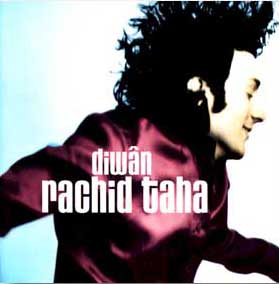 imagery of the text. In “Bani al-Insan,” (“The Human Race”), Taha re-orchestrates the song by Nass El-Ghiwan, the popular Moroccan group from the 70s and 80s. Nass El-Ghiwan sang revolutionary lyrics using mystic beats from the gnawa tradition—a ritualistic practice that mixes Islamic and Sub-Saharan musics—to express their dismay at the social and political conditions in Morocco. Their lead vocalist, Boujemaa’ Hgour, attained legendary status when he died suddenly of a drug overdose, but most Moroccans believe that he was poisoned by the government because of his politically charged lyrics. “Bani al-Insan” strengthens the pessimistic and fatalistic vision of “Ya Rayah” when Taha sings: “My love, oh how much I love you / A calamity from the sky struck you down / Faced with this disaster / I am powerless.” The calamity striking the beloved/homeland is left open ended and unexplained, a further elaboration of the mehna and sense of loss. To this end, Khaled’s early songs of “El Harba Wayn” (“Where to Flee”) and “Wally L’Dark” (“Go Back Home”) gain even greater relevance, not only in their resistance against the Algerian government, but also by voicing dismay regarding the hostile conditions of Algerian immigrants in Europe. “Where to Flee” shows the same pessimism as “Ya Rayah,” as the new generation find themselves surrounded by harsh political realities and the diaspora.
imagery of the text. In “Bani al-Insan,” (“The Human Race”), Taha re-orchestrates the song by Nass El-Ghiwan, the popular Moroccan group from the 70s and 80s. Nass El-Ghiwan sang revolutionary lyrics using mystic beats from the gnawa tradition—a ritualistic practice that mixes Islamic and Sub-Saharan musics—to express their dismay at the social and political conditions in Morocco. Their lead vocalist, Boujemaa’ Hgour, attained legendary status when he died suddenly of a drug overdose, but most Moroccans believe that he was poisoned by the government because of his politically charged lyrics. “Bani al-Insan” strengthens the pessimistic and fatalistic vision of “Ya Rayah” when Taha sings: “My love, oh how much I love you / A calamity from the sky struck you down / Faced with this disaster / I am powerless.” The calamity striking the beloved/homeland is left open ended and unexplained, a further elaboration of the mehna and sense of loss. To this end, Khaled’s early songs of “El Harba Wayn” (“Where to Flee”) and “Wally L’Dark” (“Go Back Home”) gain even greater relevance, not only in their resistance against the Algerian government, but also by voicing dismay regarding the hostile conditions of Algerian immigrants in Europe. “Where to Flee” shows the same pessimism as “Ya Rayah,” as the new generation find themselves surrounded by harsh political realities and the diaspora.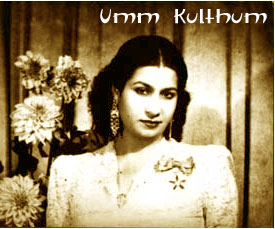 mastery of the mode of the piece, and the ensuing variations and improvisation. Not only do rai songs often lack modulation, another supposed “violation” of a long established tradition, but Arab critics also claim that by relying on recordings, the musicians cannot communicate their auras to the audience. Without this fundamental interaction, an artist might be criticized as someone who cannot communicate his/her emotions. The audience feels cheated because of the loss of physical contact traditionally involved in live performance. Arab artists through the 70s had relied on vocal and instrumental virtuosity to influence their audiences. Farid al-Atrash was a renowned ud player who mesmerized his audience by playing improvised passages (taqasim) during his live performances. Similarly, Umm Kulthum displayed her virtuosity and control of the maqam by singing long and complex songs that spanned over sixty minutes (Racy, “Creativity” 7–28; Racy, “Many Faces” 302–320).
mastery of the mode of the piece, and the ensuing variations and improvisation. Not only do rai songs often lack modulation, another supposed “violation” of a long established tradition, but Arab critics also claim that by relying on recordings, the musicians cannot communicate their auras to the audience. Without this fundamental interaction, an artist might be criticized as someone who cannot communicate his/her emotions. The audience feels cheated because of the loss of physical contact traditionally involved in live performance. Arab artists through the 70s had relied on vocal and instrumental virtuosity to influence their audiences. Farid al-Atrash was a renowned ud player who mesmerized his audience by playing improvised passages (taqasim) during his live performances. Similarly, Umm Kulthum displayed her virtuosity and control of the maqam by singing long and complex songs that spanned over sixty minutes (Racy, “Creativity” 7–28; Racy, “Many Faces” 302–320).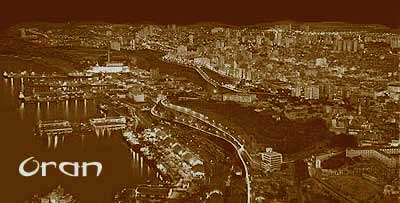 of American and European rock, supplement a long tradition of Western supremacy and racist attitudes against Arabs. Unfortunately, the Western projection of “threat” onto all Middle Eastern influences prevents an ideologically open curiosity among some Western music audiences. Western curiosity toward “Oriental culture” has always been limited and narrowed by its perspective of the outside looking in, the above looking down. Those who dismiss rai in France describe it as being “too foreign, too primitive, too exotic, too strange” (Lipsitz 124). Unfortunately, these negative views veil the interconnectedness between cultures and their complex dynamics. They further obscure the positive borrowings and cooperation resulting from the “dangerous crossroads” outlined by George Lipsitz.
of American and European rock, supplement a long tradition of Western supremacy and racist attitudes against Arabs. Unfortunately, the Western projection of “threat” onto all Middle Eastern influences prevents an ideologically open curiosity among some Western music audiences. Western curiosity toward “Oriental culture” has always been limited and narrowed by its perspective of the outside looking in, the above looking down. Those who dismiss rai in France describe it as being “too foreign, too primitive, too exotic, too strange” (Lipsitz 124). Unfortunately, these negative views veil the interconnectedness between cultures and their complex dynamics. They further obscure the positive borrowings and cooperation resulting from the “dangerous crossroads” outlined by George Lipsitz.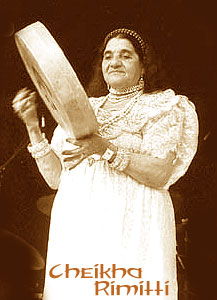 reproduced a synthesis uniting prosodies of the maddahat (religious entertainers who sang before women only) with sensual themes of love. Singing in the 1930s, Remitti’s lyrics were graphic and daring. In one of her songs, “Habib el-Khater,” for example, she explicitly described a night with her lover by singing: “It was a single bed and my lover and I slept in it. He scratched my back and I gave him all of me.” The lyrics must have brought an outcry of shock from the rest of the society that Remitti defiantly ignored. Remitti further denounced forced marriages between older men and younger women and encouraged women to enjoy their sexuality, to indulge in its pleasure, and to “break the fast.” (Mezouane). Remitti’s song “Wayn rak tergoud?” (“Where will you sleep tonight?”) embodies most of the rai traits: its hot lyrics are complemented by her low voice and strong sense of presence, which give her an unyielding appeal and asala (authenticity).
reproduced a synthesis uniting prosodies of the maddahat (religious entertainers who sang before women only) with sensual themes of love. Singing in the 1930s, Remitti’s lyrics were graphic and daring. In one of her songs, “Habib el-Khater,” for example, she explicitly described a night with her lover by singing: “It was a single bed and my lover and I slept in it. He scratched my back and I gave him all of me.” The lyrics must have brought an outcry of shock from the rest of the society that Remitti defiantly ignored. Remitti further denounced forced marriages between older men and younger women and encouraged women to enjoy their sexuality, to indulge in its pleasure, and to “break the fast.” (Mezouane). Remitti’s song “Wayn rak tergoud?” (“Where will you sleep tonight?”) embodies most of the rai traits: its hot lyrics are complemented by her low voice and strong sense of presence, which give her an unyielding appeal and asala (authenticity).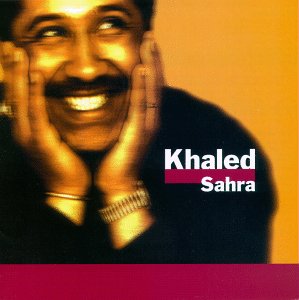 Like many of his Western counterparts, Khaled lives the image of a rebel by violating and advocating (without contradictions) his culture’s moral guidelines according to his wish. Many pop stars use their controversial image for the sake of generating publicity and attracting attention, and Khaled is no exception: his dress, videos, lyrics, and music are considered by many Arabs as inappropriate because he crosses the boundaries of socially acceptable moral codes. Schade-Poulsen summarizes his reaction to Khaled’s image:
Like many of his Western counterparts, Khaled lives the image of a rebel by violating and advocating (without contradictions) his culture’s moral guidelines according to his wish. Many pop stars use their controversial image for the sake of generating publicity and attracting attention, and Khaled is no exception: his dress, videos, lyrics, and music are considered by many Arabs as inappropriate because he crosses the boundaries of socially acceptable moral codes. Schade-Poulsen summarizes his reaction to Khaled’s image: